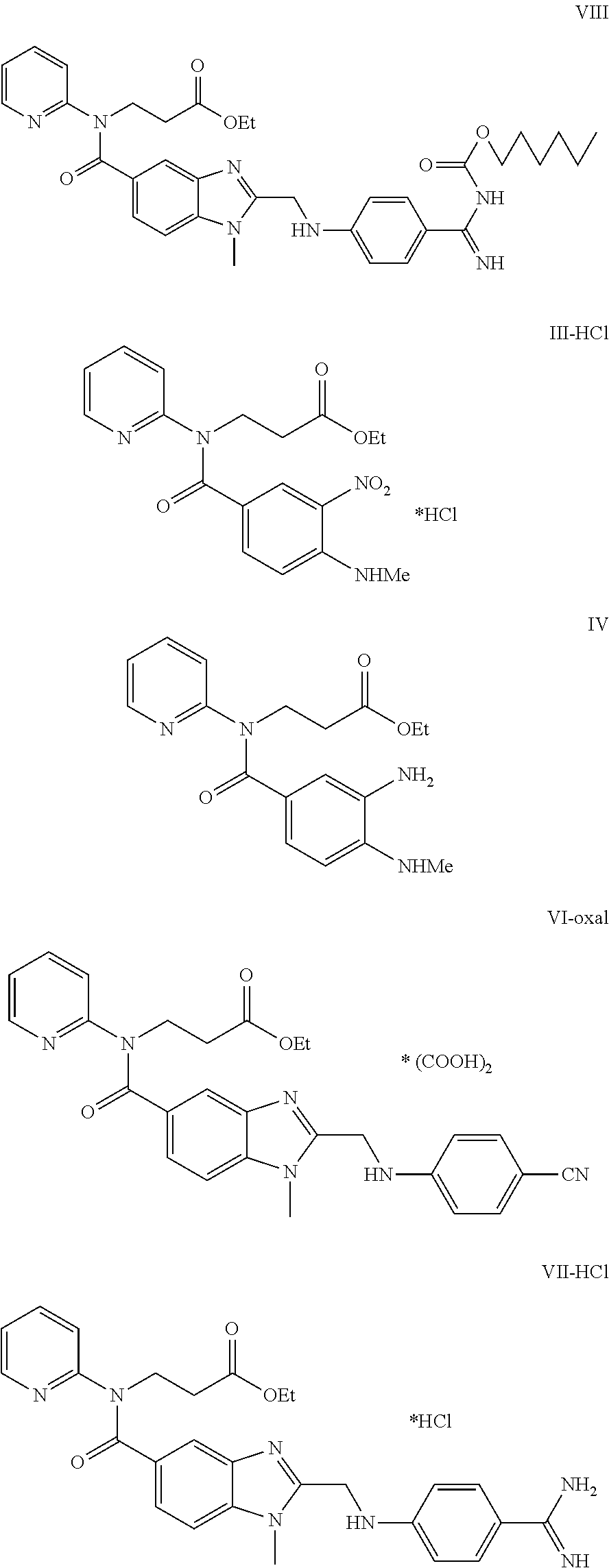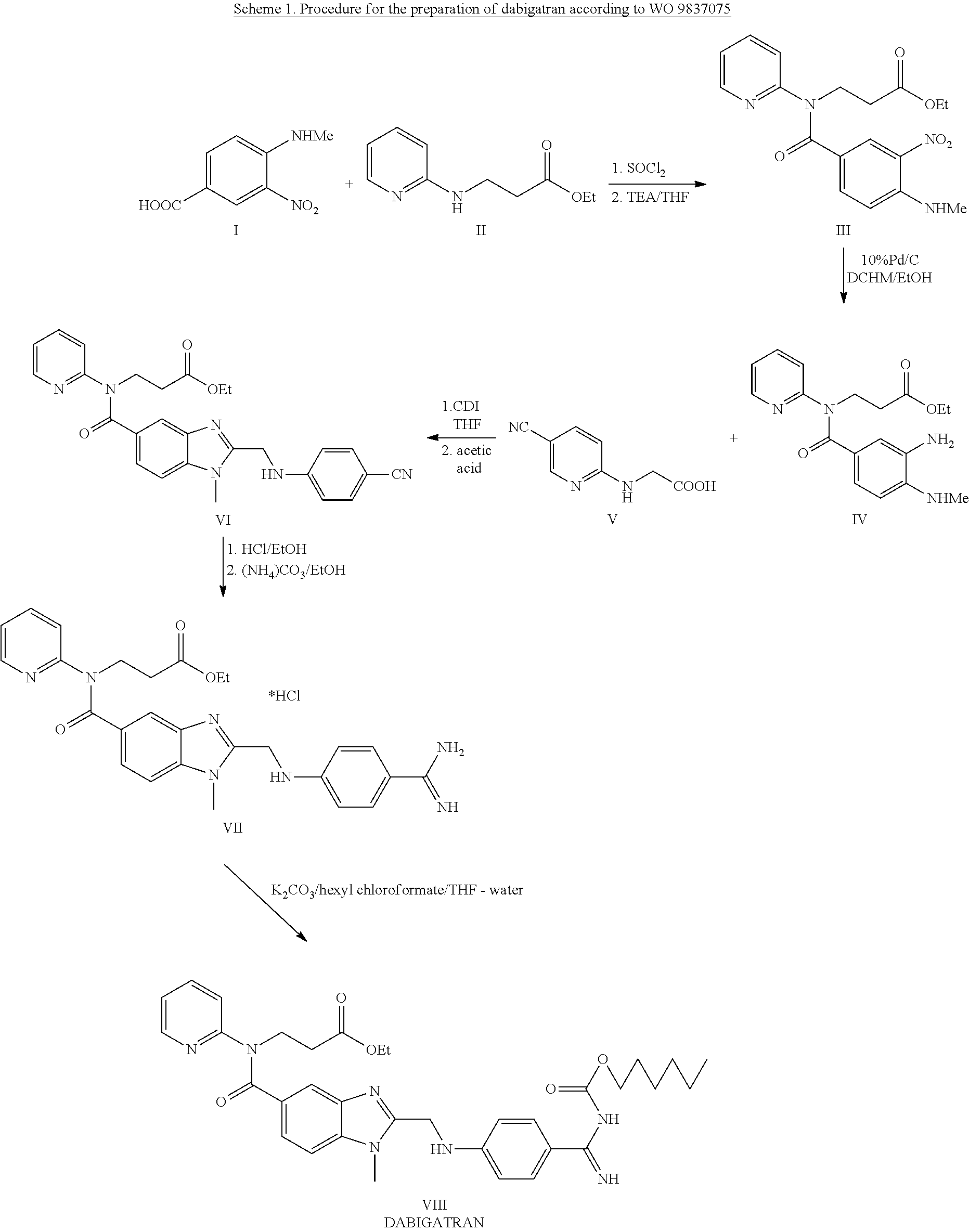Method for the preparation of dabigatran
a technology of dabigatran and dabigatran ether, which is applied in the field of dabigatran preparation, can solve the problems of toxic catalysts, high technological demands of processes, and high safety and environmental risks
- Summary
- Abstract
- Description
- Claims
- Application Information
AI Technical Summary
Problems solved by technology
Method used
Image
Examples
example 2
Preparation of ethyl 3-[[3-amino-4-(methylamino)benzoyl](pyridin-2-yl)amino]-propanoate (IV)
[0051]
[0052]Ingredients
[0053]Intermediate III: 120 g-0.29 mol
[0054]Sodium dithionite: 246 g-1.2 mol
[0055]Ethanol: 750 ml
[0056]Ethyl acetate: 600 ml
[0057]Substance III was put into 1500 ml of the ethanol—water mixture 1:1 and heated up to 50° C. This way a solution was created to which solid sodium dithionite was added quickly and under intensive stirring. After the starting substance has reacted the reaction mixture was concentrated in a vacuum evaporator. After separation of oil the concentration was completed and the product was extracted with ethyl acetate. After its drying with sodium sulphate the solvent is evaporated. The product is obtained as a brown, very viscous liquid.
[0058]Yield: 82 g (81.3%); HPLC: 95%
example 3
3.2.3 Preparation of [(4-cyanophenyl)amino]acetic acid (V)
[0059]
[0060]Ingredients
[0061]F: 90 g-0.75 mol
[0062]G: 211.7 g-1.5 mol
[0063]Sodium bicarbonate: 35 g, 0.42 mol
[0064]The starting substances F and G were mixed in 1250 ml of water and this suspension was inserted into a bath heated up to 100-110° C. After three hours of heating the reaction container was removed from the bath, cooled in the fridge and the separated substance was sucked off. The substance was dried in a vacuum drier at the temperature of 100° C.
[0065]Yield:
[0066]Crude product: 122 g (92.8%), HPLC: 97%
[0067]The crude product was purified by conversion to the sodium salt and re-acidification using an aqueous solution of sodium bicarbonate. The acid was released by means of diluted hydrochloric acid (1:1). After sucking off and washing with water the product was dried in a vacuum drier (105° C.).
[0068]Yield:
[0069]Purified product: 115 g (88%), HPLC: 99.1%, water content: 0.13%; sulphate ash: 1.8%
example 4
Preparation of 3-([2-[(4-cyanophenyl amino)-methyl]-1-methyl-1H-benzimidazole-5-carbonyl]-pyridin-2-yl-amino)ethyl propionate oxalate (VI)
[0070]
[0071]Ingredients
[0072]Intermediate IV: 82.5 g-0.24 mol
[0073]Intermediate V: 46.4 g-0.26 mol
[0074]1,1′-carbonyldiimidazole (CDI): 42.2 g-0.26 mol
[0075]Procedure
[0076]Substance V and 1,1′-carbonyldiimidazole are put into a flask blown with an inert gas. 2000 ml of dry THF are added and the mixture is boiled under a reflux condenser with a calcium-chloride tube for 40 minutes. After 40 minutes a solution of substance IV in 330 ml of dry THF is added to the mixture and the mixture is boiled for another 5 hours. After expiration of this time period the reaction mixture is slightly cooled and THF is removed by distillation in vacuum.
[0077]1000 ml of glacial acetic acid are added to the honey-like brown residue and the resulting solution is boiled for 1 hour. The acid is distilled off and the produced residue is dissolved in dichloromethane (850 m...
PUM
| Property | Measurement | Unit |
|---|---|---|
| temperature | aaaaa | aaaaa |
| temperature | aaaaa | aaaaa |
| temperature | aaaaa | aaaaa |
Abstract
Description
Claims
Application Information
 Login to View More
Login to View More - R&D
- Intellectual Property
- Life Sciences
- Materials
- Tech Scout
- Unparalleled Data Quality
- Higher Quality Content
- 60% Fewer Hallucinations
Browse by: Latest US Patents, China's latest patents, Technical Efficacy Thesaurus, Application Domain, Technology Topic, Popular Technical Reports.
© 2025 PatSnap. All rights reserved.Legal|Privacy policy|Modern Slavery Act Transparency Statement|Sitemap|About US| Contact US: help@patsnap.com



